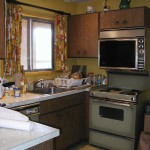Show of hands – how many of you grew up in a home with shag carpeting? Harvest gold appliances? Brass fixtures? (And for those of you willing to admit this, how many had mullets or wore their sweatshirts hanging off one shoulder ala Jennifer Beals in Flashdance?)
In my last post, I wrote about finding a unique and interesting book while browsing in my local bookstore. Since then, I’ve seen my book in several places, most recently in People magazine as a recommended summer read (kudos to author Claudia Kalb!). While I love being on-trend and finding the latest “in” thing, there’s definitely a limit.
Had Pinterest (or Houzz or HGTV for that matter) been around in the 1970s, I’m sure harvest gold or avocado green appliances and wood-paneled living rooms would have been the dominating themes. (My neighbor has confided that her parents had both – the gold appliances and a green kitchen, complete with green cabinetry everywhere and green colonial-patterned wallpaper, also everywhere. And she tells me there was also shag carpeting in the living room and wood paneling in the basement, in case you were wondering.)
In the 80s and early 90s, polished or brass fixtures dominated, which have been replaced with brushed nickel and stainless steel appliances, which in turn, are increasingly being supplanted by black, colored, or cabinetry-faced styles. And of course there’s the barn door trend (which for my money is the next thing to go, despite its being a super neat design element that I would even like in my own house).
So what does stand the test of time and how do you make the right design decisions, especially with all of the design inspiration resources widely available? One thing I try to do with my clients is to step back from obsessing about the Pinterest-worthy design details and focus more on the bigger picture, especially the overall design, layout, and functionality. (After all, a dysfunctional layout doesn’t work, regardless of whether it’s avocado green, brass, or granite.)
Asking these questions can help keep things in perspective: How hard will the materials be to maintain? (True confession time – I had to have black kitchen cabinets but I quickly found out that they show EVERY LITTLE speck of dirt and are difficult to keep clean.) How will a space actually be used and who will be using it (kids? pets?)? What is the impact on the home’s resale value? And perhaps most importantly, will my clients still love the space in a year? Ten years? What about the next owners?
Once the overall design has been completed, adding one or two trendy items as a focal point to work with an overall palate of timelessness can add a fresh and modern flair (even if the design is vintage). For example, one colored appliance – the stove or refrigerator – within a neutral palette adds intensity and a fun vibe. Focusing on comfort, ergonomics, low maintenance, and just plain functionality (how easy a space is to relax in and use) is also a good way to identify and eliminate trends that may not stand the test of time. Finally, consider opting for a design detail that will be easy to change in the future. Swapping out a barn door for a more typical swinging unit is easier and cheaper to replace in a few years than a countertop or cabinets, so go with that look now but select a classic cabinetry style and material that can work with a variety of different accessories and styles.
In the end, it is all about finding the right balance between cutting-edge and timeless classics. After all, a little black dress looks good on everyone, even someone who still wears their hair in a mullet!
